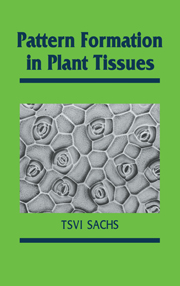Book contents
- Frontmatter
- Contents
- Preface
- 1 Introduction
- 2 Interactions of developing organs
- 3 Hormones as correlative agents
- 4 Callus and tumor development
- 5 The polarization of tissues
- 6 The canalization of vascular differentiation
- 7 Cell lineages
- 8 Stomata as an example of meristemoid development
- 9 Expressions of cellular interactions
- 10 Apical meristems
- 11 The localization of new leaves
- 12 A temporal control of apical differentiation
- 13 Generalizations about tissue patterning
- References
- Author Index
- Subject Index
4 - Callus and tumor development
Published online by Cambridge University Press: 05 October 2009
- Frontmatter
- Contents
- Preface
- 1 Introduction
- 2 Interactions of developing organs
- 3 Hormones as correlative agents
- 4 Callus and tumor development
- 5 The polarization of tissues
- 6 The canalization of vascular differentiation
- 7 Cell lineages
- 8 Stomata as an example of meristemoid development
- 9 Expressions of cellular interactions
- 10 Apical meristems
- 11 The localization of new leaves
- 12 A temporal control of apical differentiation
- 13 Generalizations about tissue patterning
- References
- Author Index
- Subject Index
Summary
Cells close to a wounded surface often divide. These divisions result in a tissue known as callus: a mass of relatively large cells without obvious shape or organization (Figs. 4.1, 4.2; Küster, 1925). The growth of callus generally ceases after a short time, when the wound is covered and the various parts of the plant and their vascular connections have regenerated. Occasionally callus growth does continue and large masses of tissue are formed. Such callus, whose growth is unlimited, is a tumor comparable to animal cancer (Figs. 4.1, 4.2; DeRopp, 1951; Braun, 1978). Unlimited callus growth also occurs in tissue culture: when parts of the plant are isolated on a medium that provides all the substances necessary for growth (Gautheret, 1959; Murashige, 1974).
The previous two chapters dealt with the correlative relations of the development of organized structures. It is now necessary to ask about the correlative relations of unorganized development, the development of callus and tumors. Is this development related to, and influenced by, the hormonal signals involved in organ relations? This question is significant because any positive answer, partial though it may be, would indicate that long-distance interactions between organs could also be important for the cellular organization of tissues.
- Type
- Chapter
- Information
- Pattern Formation in Plant Tissues , pp. 38 - 51Publisher: Cambridge University PressPrint publication year: 1991
- 10
- Cited by

